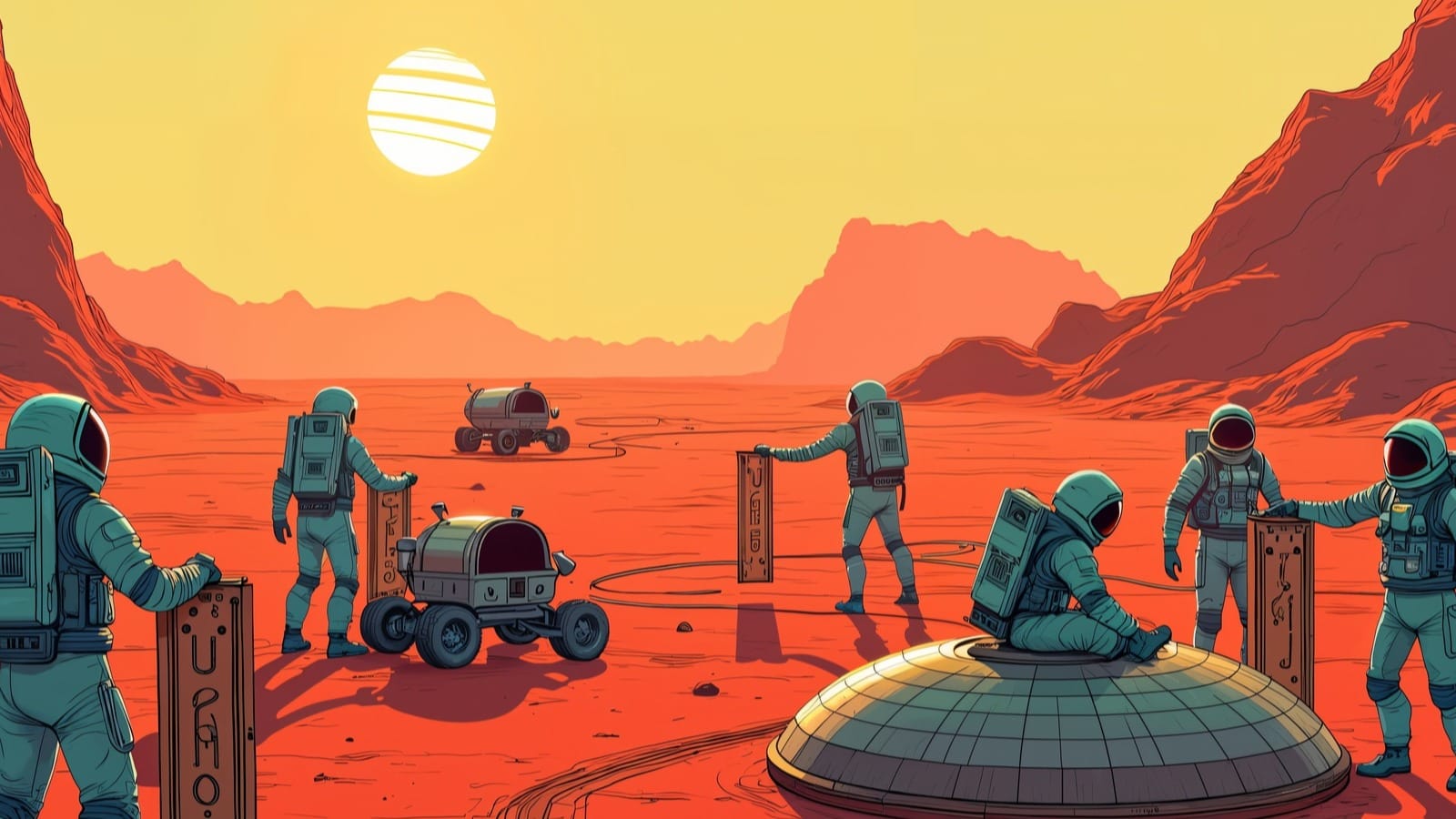Elon Musk’s Complete A-to-Z Mars Colonization Master Plan
In the annals of human ambition, few visions rival Elon Musk’s audacious plan to establish a self-sustaining civilization on Mars. As SpaceX edges closer to making interplanetary travel a reality, Musk’s strategy for colonizing the Red Planet has evolved into one of the most ambitious projects in human history. This article explores every facet of his Mars colonization roadmap, from current developments to the ultimate goal of housing one million people on Mars by 2050.
The Vision: Why Mars
Musk’s Mars obsession stems from a fundamental belief about humanity’s long-term survival. “Eventually, all life on Earth will be destroyed by the sun,” Musk explains, Earth might only have about 450 million years left before the Sun gets bigger and makes it impossible to live here. However, more immediate threats—nuclear war, artificial intelligence gone rogue, pandemics, or climate disasters—could end civilization much sooner.
“The fundamental fork in the road for human destiny is where Mars can continue to grow even if the supply ships from Earth stop coming,” Musk declared at SpaceX’s Starbase facility. This philosophy of making humanity “multiplanetary” drives every aspect of his Mars strategy, transforming it from science fiction fantasy into a structured, executable plan backed by billions in investment and cutting-edge technology.
Mars presents the most viable option for colonization due to its 24.6-hour day cycle, seasonal changes, polar ice caps containing water, and thin but existing atmosphere composed primarily of carbon dioxide. Unlike the Moon’s vacuum or Venus’s crushing atmosphere, Mars offers conditions that, while challenging, remain within the realm of human adaptation with appropriate technology.
Current Timeline and Mission Windows
2025-2026: The Critical Launch Window
SpaceX faces a crucial 18-month window to achieve its first Mars mission by late 2026. The optimal Earth-Mars alignment occurs every 26 months, creating brief opportunities when the journey takes only 7-9 months instead of years. Musk estimates a “50-50 chance” of meeting the 2026 deadline, contingent on mastering orbital refueling technology.
The first mission will deploy five uncrewed Starships to Mars, primarily carrying Tesla’s Optimus humanoid robots to conduct initial surface operations. These robots will handle the dangerous work of establishing basic infrastructure, testing equipment, and preparing landing sites for human arrival.
2028-2030: Infrastructure Development
If the 2026 missions succeed, SpaceX plans to dramatically scale operations during the 2028-29 launch window. This phase involves sending approximately 20 Starships carrying essential infrastructure components:
Solar panel arrays for power generation
Landing pad construction equipment
Resource extraction machinery
Habitat modules and life support systems
Propellant production facilities
2030-2035: First Human Missions
The early 2030s mark the anticipated arrival of the first human crews on Mars. Initial missions will consist of approximately 12 people focused on establishing “Mars Base Alpha”—a rudimentary settlement designed to prove human survival capabilities. These astronauts will spend several months on the surface, conducting scientific research while building the foundation for permanent habitation.
2050: The Million-Person City
Musk’s ultimate goal involves transporting one million people to Mars by 2050, using a fleet of 1,000 reusable Starships. This massive undertaking would require launching hundreds of ships during each 26-month window, creating regular “highways” between Earth and Mars.
Technical Challenges and Solutions
Radiation Protection: The Invisible Killer
Mars lacks Earth’s protective magnetosphere and thick atmosphere, exposing surface dwellers to dangerous levels of galactic cosmic rays and solar energetic particles. Measurements from NASA’s Curiosity rover reveal that astronauts would receive at least 0.66 sieverts during a round trip—more than three times the recommended lifetime limit for space workers.
SpaceX is developing multiple radiation mitigation strategies:
Advanced Shielding Materials: Hydrogenated boron nitride nanotubes (BNNTs) represent a breakthrough technology that could be woven directly into spacesuit fabric while providing superior radiation protection.
Underground Habitation: Using The Boring Company’s tunneling expertise, Mars colonists will live in underground cities protected by layers of Martian regolith. Recent renders show extensive subterranean communities connected by tunnel networks.
Water-Based Shielding: Habitat walls incorporating water and Martian soil provide natural radiation barriers while serving dual purposes for life support.
Life Support and Resource Utilization
Surviving on Mars requires completely closed-loop life support systems that recycle air, water, and waste with near-perfect efficiency. SpaceX has partnered with various companies to develop these critical technologies:
The Sabatier Process: This chemical reaction converts atmospheric CO2 and hydrogen into methane fuel and water. The process operates at 300-400°C using nickel catalysts and produces the exact fuel Starship needs for return journeys.
Water Extraction: Mars contains substantial water ice, particularly in the Arcadia Planitia region where SpaceX plans its initial landings. Advanced electrolysis systems will split this water into hydrogen and oxygen for fuel and breathing.
Food Production: Hydroponic and aeroponic systems will grow crops in controlled environments. SpaceX is already testing partnerships with companies like Impossible Foods to develop sustainable protein sources for Martian colonists.
Heat Shield Technology: The Mars Entry Challenge
One of Starship’s most complex engineering challenges involves developing a reusable heat shield capable of surviving multiple entries into Mars’ atmosphere. Unlike Earth entry, Mars presents unique difficulties:
CO2-rich atmosphere creates 2-3 times more oxygen when heated to plasma temperatures
Thin atmosphere (1% of Earth’s density) provides less drag for slowing down
The oxidizing environment “wants to oxidize the hell out of the heat shield,” as Musk explains
SpaceX’s current heat shield consists of approximately 14,000 hexagonal tiles made from advanced ceramics, glass, alumina, and carbon compounds. Continuous testing in simulated Martian conditions helps refine these materials for the extreme entry environment.
Infrastructure and City Planning
Landing Site Selection: Arcadia Planitia
SpaceX has identified Arcadia Planitia, a volcanic plain in Mars’ northern hemisphere, as the primary location for initial settlements. This region offers several advantages:
Abundant near-surface water ice detected by Mars Reconnaissance Orbiter
Flat terrain suitable for landing large spacecraft
Low elevation providing slightly thicker atmosphere for better landing conditions
Optimal solar energy exposure for power generation
Reduced radiation exposure compared to higher elevations
Urban Design and Architecture
Internal SpaceX documents reveal detailed city planning centered around dome habitats and underground facilities. The colony design features:
Central Dome: A large communal living space serving as the city’s heart, surrounded by smaller specialized domes for various functions.
Underground Networks: Extensive tunnel systems connecting habitats, workshops, and production facilities, all protected from radiation and dust storms.
Transportation Infrastructure: Plans include hyperloop connections between settlements and potential space elevators using Phobos as an anchor point by the 2090s.
Resource Processing Facilities: Industrial complexes for fuel production, water processing, food cultivation, and manufacturing.
The Role of SpaceX’s Ecosystem
Starship: The Mars Transportation System
Starship represents the cornerstone of Mars colonization, designed as a fully reusable super-heavy lift vehicle capable of carrying 100-150 tons of cargo or 100 passengers to Mars. Current specifications include:
Dimensions: Nearly 400 feet tall when combined with Super Heavy booster
Propulsion: Powered by Raptor engines using methane and oxygen—fuels that can be produced on Mars
Refueling: Requires 8-16 tanker flights to fully refuel in Earth orbit for Mars missions
Cost Target: Eventually $2-10 million per launch, dramatically reducing space transportation costs
Production and Manufacturing
SpaceX plans to manufacture Starships at unprecedented rates, with Musk targeting 1,000 vehicles annually once production reaches full capacity. Current production focuses on iterative improvements:
Raptor Engine Manufacturing: SpaceX already produces approximately one Raptor engine per day at costs around $500,000 each—roughly 1/40th the price of comparable engines.
Block 3 Starships: Next-generation vehicles expected by end of 2025 will feature improved performance, reliability, and payload capacity.
Launch Cost Reduction: Through reusability, SpaceX aims to reduce launch costs to $15-95 per kilogram—potentially 100 times cheaper than current alternatives.
Integration with Other Musk Companies
Musk’s Mars vision leverages his entire business ecosystem:
Tesla: Provides Cybertruck-based vehicles for Mars surface transportation, Optimus robots for dangerous tasks, and massive solar panel arrays for power generation.
The Boring Company: Develops tunneling equipment specifically designed for Mars conditions, creating underground cities and transportation networks.
Neuralink: Could potentially help astronauts cope with psychological challenges of long-duration space missions and communication delays with Earth.
X (formerly Twitter): Serves as a testing ground for consensus-based governance systems that might govern Mars colonies.
Terraforming: The Nuclear Option
Musk’s Controversial “Nuke Mars” Plan
Perhaps the most audacious aspect of Musk’s vision involves terraforming Mars through controlled thermonuclear explosions over the planet’s polar ice caps. This strategy aims to:
Vaporize CO2 and water from polar ice caps
Thicken Mars’ atmosphere through increased greenhouse gases
Trigger cascading warming effects across the planet
Eventually create conditions suitable for liquid water and plant life
Technical Feasibility and Challenges
Scientific analysis suggests Musk’s nuclear terraforming plan faces significant obstacles:
Insufficient CO2: Even vaporizing all accessible CO2 on Mars would only increase atmospheric pressure to 7-14% of Earth’s level.
Atmospheric Loss: Mars continues losing atmosphere to space due to its lack of magnetosphere, potentially negating terraforming gains over time.
Nuclear Requirements: Estimates suggest needing over 10,000 nuclear weapons—most of Earth’s existing arsenal—to attempt meaningful atmospheric change.
Radiation Contamination: Nuclear detonations would irradiate large areas of Mars, potentially hampering colonization efforts.
Despite these challenges, Musk remains committed to the concept, even selling “Nuke Mars” t-shirts through SpaceX’s merchandise store.
Economic Considerations and Funding
Investment Requirements
Mars colonization represents one of history’s most expensive undertakings. Musk’s 2024 estimates suggest building a self-sustaining Mars city would require over $1,000 trillion—nearly 10 times Earth’s total GDP. However, these figures likely reflect worst-case scenarios using current technology costs.
Cost Reduction Strategies
SpaceX focuses on dramatic cost reductions through:
Reusability: Starship’s complete reusability could reduce launch costs by 99% compared to expendable rockets.
Mass Production: Manufacturing 1,000 Starships at scale should significantly reduce per-unit costs.
In-Situ Resource Utilization: Using Martian resources for fuel, water, and construction materials eliminates expensive Earth-based supply chains.
Funding Sources
Mars colonization funding will likely come from multiple sources:
SpaceX’s commercial satellite launch business
NASA partnerships and government contracts
Private investment and space tourism revenue
Eventually, Mars-based economic activities and resource exports
Health and Human Factors
Physiological Challenges
Living on Mars presents numerous health risks beyond radiation exposure:
Reduced Gravity: Mars gravity (38% of Earth’s) may cause bone density loss, muscle atrophy, and cardiovascular deconditioning over time.
Psychological Factors: Isolation, confinement, and communication delays with Earth (4-24 minutes) create significant mental health challenges.
Medical Emergencies: Limited medical facilities and inability to evacuate to Earth during most of the 26-month cycle between launch windows.
Reproductive Considerations
Musk has expressed particular interest in whether humans can successfully reproduce on Mars. SpaceX medical teams are researching:
Effects of reduced gravity on pregnancy and fetal development
Potential genetic modifications to help humans adapt to Martian conditions
Creating sustainable population growth within the colony
Musk has even volunteered his own sperm to help establish the initial Martian population, demonstrating his personal commitment to the colony’s genetic diversity.
Recent Developments and Partnerships
International Collaboration
SpaceX has begun securing its first commercial customers for Mars missions. The Italian Space Agency has signed agreements to send scientific payloads on early Starship flights, with more international partnerships expected.
Government Relations
While initially independent, SpaceX increasingly collaborates with NASA on Mars-related technologies through the Artemis lunar program, using Moon missions as testing grounds for Mars systems.
Technological Progress
Recent Starship test flights have achieved significant milestones:
Successful orbital flights and controlled landings
Heat shield testing for atmospheric entry
Raptor engine reliability improvements
Progress toward orbital refueling demonstrations
Environmental and Ethical Considerations
Planetary Protection
Mars colonization raises complex questions about contaminating a potentially life-bearing world. Current protocols aim to:
Sterilize equipment before Mars deployment
Conduct thorough searches for existing Martian life
Establish protected zones free from human interference
Develop reversible colonization strategies if necessary
Resource Rights and Governance
As Mars settlements grow, questions of resource ownership, territorial claims, and governmental structures become critical. Musk envisions direct democratic systems where colonists vote on major decisions, potentially testing these concepts through X’s social media platform.
Future Phases and Long-Term Vision
2040s-2050s: Scaling and Expansion
By the 2040s, Musk envisions regular transportation between Earth and Mars with hundreds of flights per launch window. Mars colonies would expand beyond initial settlements to include:
Multiple cities across different Martian regions
Industrial manufacturing capabilities
Scientific research institutions
Tourism and entertainment facilities
2060s and Beyond: True Self-Sufficiency
The ultimate goal involves Mars colonies becoming completely independent of Earth support. This includes:
Complete technological and industrial self-sufficiency
Sustainable population growth exceeding one million people
Potential terraforming activities to improve planetary conditions
Expansion to other worlds including Jupiter’s moons
Interplanetary Civilization
Musk’s vision extends beyond Mars to creating a truly multiplanetary human civilization. Success on Mars would provide templates and technologies for colonizing other worlds, ensuring humanity’s long-term survival regardless of what happens to Earth.
Conclusion: Humanity’s Next Chapter
Elon Musk’s Mars colonization plan represents humanity’s most ambitious undertaking—a strategy to establish civilization on another world within the next 25 years. While technical challenges remain formidable and costs appear staggering, SpaceX’s rapid progress and innovative approaches suggest this vision is transitioning from science fiction to engineering reality.
The success of this endeavor depends on numerous factors: technological breakthroughs, international cooperation, sustained funding, and humanity’s collective will to become a multiplanetary species. Yet with each Starship test flight, each technological milestone, and each new partnership, Musk’s Mars city moves closer to reality.
Whether driven by existential risk mitigation, scientific curiosity, or simple human wanderlust, the Mars colonization project represents a defining moment in human history. As Musk frequently notes, this may be our first and best opportunity to establish life beyond Earth—a chance to ensure that consciousness and civilization persist regardless of what the future holds for our home planet.
The countdown to Mars has begun. In less than 18 months, we may witness the first Starships departing for the Red Planet, carrying with them humanity’s hopes for a multiplanetary future. Musk’s plan provides the roadmap—now comes the challenge of making it reality.





What the hell is this